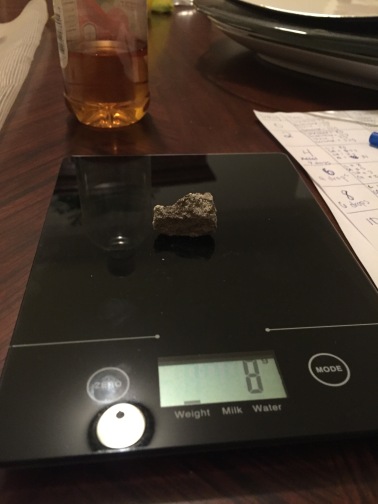Conclusion:
The hypothesis for this experiment was that if drops of vinegar with an acidic level of 3, were added to each of the different types of rocks, the amount of grams weathered away on limestone will be greater than granite, sandstone, and shale after ten days. Based on the analysis of the data collected, this experiment seems to have refuted the hypothesis. The amount of weathering limestone was put under was not enough to beat the amount of grams sandstone lost.
Supporting results in the refute of the hypothesis include the fact that out of the ten days vinegar was added to the rocks, lost a small amount of grams, it did although change in physical appearance. On average the amount of grams that limestone weathered away throughout the three trials was 11.3 grams. The average amount of grams weathered is similar to the result of sandstone, 11.9 grams. It is suggested that limestone and sandstone average amount was fairly similar because of their composition and the way they reacted to the vinegar. The small amount of grams that limestone weathered off supports that the hypothesis was refuted and suggest that the amount of days given for this experiment could have been longer.
To conclude on this experiment, it is clear that although the limestone reacted the best with the vinegar it did not weather the most of the four rocks that were tested. Many questions arose in the duration of this experiment, for example why did the acid that was dropped on the limestone become neutralized and the others didn’t? Although limestone is known to weather away easily for example, concrete sidewalks that have limestone in it are easily cracked or worn down, it was suggested that many of the technical errors during this experiment could have contributed to the lack of weathering of limestone. Future experiments for this may include a stronger acid to work with and more use of the acid during the experiment. This experiment could be applied to a real life test, if scientist wanted to know exactly how much acid rain has to make contact with limestone until it is completely worn away. Despite the fact that limestone barely weathered throughout the experiment, students who would want to expand this experiment could tests different types of limestone rocks to see the rate of weathering between them, and get a better understanding of each of their compositions.
Data Gaps:
During this experiment, there were many technical errors that contributed to the refute of my hypothesis, for instance when adding the drops of vinegar to each rock and letting it rest for a day before adding more, the acidic level of each rock was not taken. Many of the rocks could have become neutralized, making the vinegar no longer have effect on the rock. To avoid this from happening, the sample of rocks should be tested everyday to make sure that the vinegar being dropped on the rocks does not neutralize out.
The type of acid being used in this experiment should be stronger than a 3 on the pH scale, so that it could potentially have a bigger impact of the weathering of each rock and could show results in a better way. The amount of acid being dropped on each rock should be increased, letting the rocks have a higher chance of being weathered more efficiently.This could help get a better understanding at the rate of weathering between different rocks.
For this experiment the duration was not long enough for the rocks to start breaking down enough for it to have a definite result, making the whole experiment seem very rushed through. To avoid this, the duration of this experiment should be extended for the results to be more accurate and let the rocks break down as if they were actually outside being weathered away. This will help the ending results of the experiment become more precise and less rushed through.
